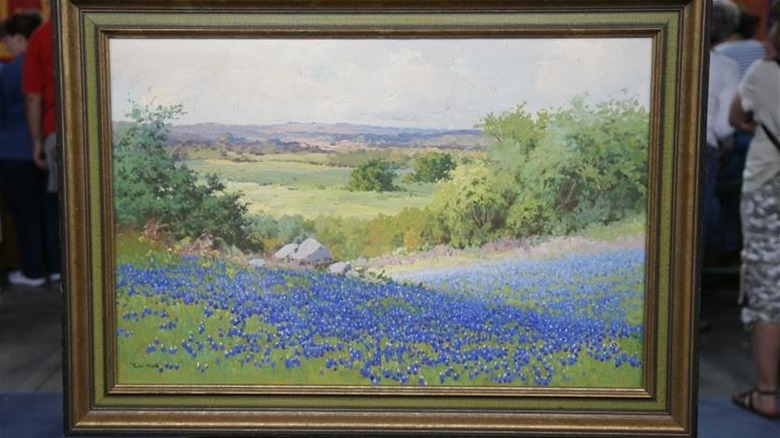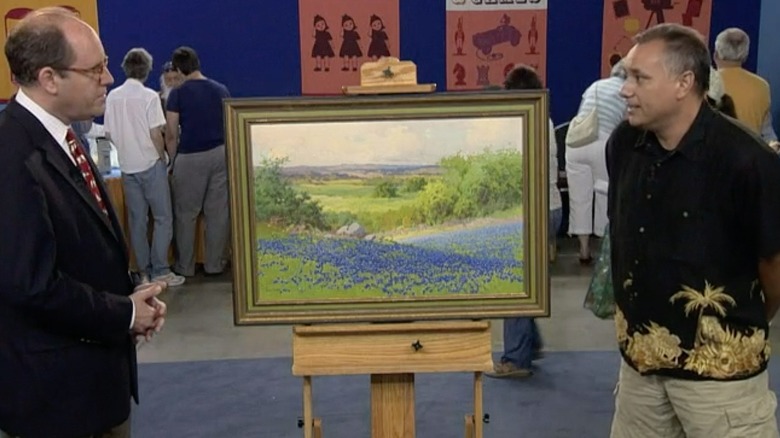Whatever Happened To Robert Wood's Painting From Antiques Roadshow?
Robert Wood was a prodigious British-born painter who made his reputation in the United States. In the early 1900s, he traveled all over America by freight train, often trading his paintings for the essentials he needed as he hoboed from place to place as an itinerant artist. According to art appraiser Alan Fausel, Wood "lived just about everywhere" in his long life (1889 to 1979). "He lived in Texas, he lived in California, he lived in Colorado, he lived in Woodstock, New York," Fausel recounted on an episode of "Antiques Roadshow" (via PBS.org). "But he was in San Antonio from 1923 to about 1941."
There, Wood painted his well-known landscapes featuring bluebonnets, which would become his most sought-after works. One of these paintings ended up on a 2007 episode of the PBS show that travels around the country and connects antique owners with appraisers. They appropriately filmed the episode in San Antonio. Fausel told the owner that because Wood painted so many paintings during his life, his work usually only sells for no more than $5,000. But there was good news since this was one of his bluebonnet paintings. "It's only of interest here in Texas, but they go crazy for these paintings," Fausel said before estimating the price of between $15,000 and $25,000 at auction. Unfortunately, an appraisal in 2022, 15 years after the episode aired, didn't change the painting's estimated value. Wood was just too prolific for his own good, which has continued to affect his prices.
Robert Wood Produced thousands of paintings
The man who brought the bluebonnet painting to "Antiques Roadshow" said Robert Wood had traded it with his aunt for room and board sometime in the 1920s or 1930s. "The story I understand is that he couldn't make rent, and so he offered a painting as payment for that," the man told Alan Fausel. The Wood painting stayed in the family and eventually came to him. After Wood left Texas, he moved to California and lived long enough to enjoy fame as an artist thanks in part to a lucrative deal to sell low-priced reproductions of his work, which greatly increased his stature, but not the value of his paintings.
"During the 1950s, Wood's works became increasingly popular in print and the royalties eventually made him a comfortable living," according to the art dealer Jeffrey Morseburg, who knew the artist (via robertwood.net). "He left a legacy of thousands of paintings, for his career lasted almost seventy years." It was this legacy, appraiser Alan Fausel pointed out, that has kept Wood's work at a lower value over the years. "[O]ne of the things about Wood is, he's so prolific, that really has depressed his market," Faucel said. "He did far too many paintings. They aren't rare enough. And the other thing about him, he was so deft at doing, he was very quick. In my business, we say he's a little slick." Whether slick or not, there are many admirers of Wood's work who are willing to pay to own an original.
Auction prices
Even with the large number of paintings that Robert Wood produced in his lifetime, the market for his work continues apace. The highest auction price obtained for a Wood painting, not unsurprisingly a landscape of bluebonnets, was $75,000 in 2019, according to MutualArt.com. His paintings can also be found in many permanent museum collections, especially in Texas. The fact that the 2022 appraisal from "Antiques Roadshow" didn't increase in the 15 years from the original estimate in 2007, when the episode first aired, shouldn't be that surprising. The television show itself best illustrates the reason. Over the years there have been many of Wood's bluebonnet paintings on "Antiques Roadshow." "It wouldn't be a complete 'Roadshow' from Texas without a bluebonnet painting," Alan Fauset mused before going on to mention that Wood's "prices have never really gone up as much as you might hope for his works."
Whether the owner of Wood's bluebonnet painting who appeared on "Antiques Roadshow" sold the work or kept it isn't known, but one thing is for sure, while the appraisal didn't go up, the artist's paintings continue to sell. "Collectors who grew up around Robert Wood's paintings or prints enjoy them because they are reminded of beautiful locations, pleasant memories, and simpler themes. His works are notable for their truth and clarity," art dealer Jeffrey Morseburg wrote. "Robert Wood will always have a place in the hearts of those who appreciate traditional art and have an affection for the unspoiled American landscape."


